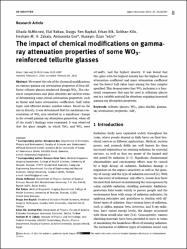The impact of chemical modifications on gamma-ray attenuation properties of some WO3-reinforced tellurite glasses

View/
Date
2023Author
Almisned, GhadaRabaa, Elaf
Şen Baykal, Duygu
Ilık, Erkan
Kılıç, Gökhan
Zakaly, Hesham M. H.
Ene, Antoaneta
Tekin, Hüseyin Ozan
Metadata
Show full item recordCitation
ALMisned, G; Rabaa, E; Şen Baykal, D; Ilık, E; Kılıç, G; Zakaly, HMH; Ene, A; Tekin, HO. The impact of chemical modifications on gamma-ray attenuation properties of some WO3-reinforced tellurite glasses. Open Chemistry (2023). 21(1).Abstract
We report the role of the chemical modifications on various gamma-ray attenuation properties of four different tellurite glasses reinforced through WO3. The chemical compositions and glass densities are used in terms of determining some critical attenuation properties, such as linear and mass attenuation coefficients, half value layer, and effective atomic number values. Based on the rise in density, it was determined that the maximum concentration of WO3 also resulted in a significant change in the overall gamma-ray absorption properties, when all of the study's findings were examined. It was observed that the glass sample, in which TeO2 and WO3 were 40 mol%, had the highest density. It was found that this glass with the highest density has the highest linear attenuation coefficient and mass attenuation coefficient and the lowest half value layer among the four samples specified. This demonstrates that WO3 inclusion is a functional component that may be used in tellurium glasses and is a suitable material for situations requiring increased gamma-ray absorption properties.
Source
Open ChemistryVolume
21Issue
1URI
https://www.degruyter.com/document/doi/10.1515/chem-2022-0297/htmlhttps://hdl.handle.net/20.500.12780/637

















